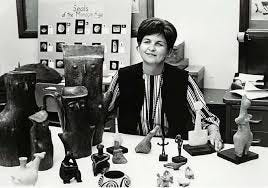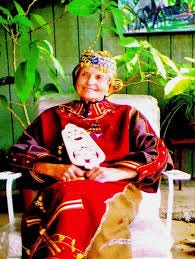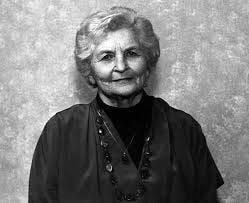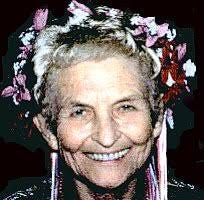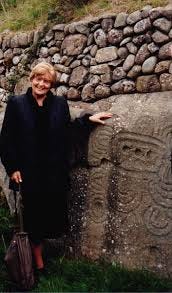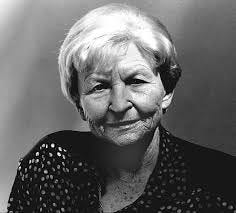Ten Blue Links of Dr. Marija Gimbutas
In the spirit of the early days of search on the World Wide Web, we curated this pathfinder from scholarly, institutional, and popular sources to highlight the life and work of Dr. Marija Gimbutas.
The Marija Gimbutas Collection
Marija Gimbutas (1921 – 1994), UCLA Professor Emerita of Archaeology, conducted pioneering interdisciplinary research on Neolithic and Bronze Age “Old Europe,” proposing a female-centered Goddess culture and the influential Kurgan hypothesis. Her personal papers and photographic archives, including ~12,000 sacred-figure images, are preserved at OPUS Archives alongside her extensive library.
Marija Gimubtas Papers and Collection of Books
Marija Gimbutas Papers and Related Book Collection (c. 1940s-1994) includes Gimbutas’s personal research files, manuscripts, correspondence, and an extensive library of her published and rare books, offering profound insight into her scholarship on Old Europe and goddess-centered cultures.
Marija Gimbutas
Marija Gimbutas (1921–1994) was a Lithuanian-American archaeologist and anthropologist renowned for her groundbreaking research on Neolithic and Bronze Age “Old Europe,” her formulation of the influential Kurgan hypothesis about Proto-Indo-European origins, and her pioneering work on goddess-centered prehistoric societies.
Marija Gimbutas
Marija Gimbutas: Lithuanian-born archaeologist; UCLA Professor Emerita whose groundbreaking work on Neolithic/Bronze Age “Old Europe,” goddess-centered cultures, and the Kurgan hypothesis reshaped understandings of prehistoric Europe.
Marija Gimbutas facts for kids
Marija Gimbutas (1921–1994) was a noted Lithuanian-American archaeologist renowned for her studies of Neolithic and Bronze Age European cultures. She developed the influential Kurgan hypothesis about the Proto-Indo-European origins and authored pivotal works on goddess-centered societies.
Marija Gimbutas’ Centennial
Marija Gimbutas’s centennial, recognized by UNESCO in 2021, was celebrated by the Institute of Archaeomythology with an international conference and exhibition exploring her enduring influence on archaeology and goddess-centered scholarship
Remembering Marija Gimbutas
The Italian archaeological platform Preistoria in Italia commemorates Marija Gimbutas with a tribute highlighting her influential work on Neolithic “Old Europe,” goddess-centered cultures, and the Kurgan hypothesis, emphasizing her legacy in European prehistoric studies.
Marija Gimbutas: Unearthing the Goddess, Rocking My World, Lithuanian-American Woman Writer and Archaeologist (1921-1994)
Theresa C. Dintino reflects on Marija Gimbutas (1921–1994), a trailblazing Lithuanian-American archaeologist. The post, titled “Unearthing the Goddess, Rocking My World,” honors Gimbutas’s impactful exploration of goddess cultures, her challenge to patriarchal paradigms, and her lasting influence on feminist and mythological scholarship.
THE GODDESS THEORY: Controversial UCLA Archeologist Marija Gimbutas Argues That the World Was at Peace When God Was a Woman
In this 1989 feature, the L.A. Times highlighted Marija Gimbutas’s groundbreaking argument that Neolithic “Old Europe” was a peaceful, matristic society where women held spiritual authority—contrasting sharply with later patriarchal Indo-European (Kurgan) cultures . The article details how her work resonated beyond academia, inspiring artists, feminists, and eco‑spiritual communities.
The archaeologist Marija Gimbutas. Grand theories at the outskirts of modernity
Marija Gimbutas, a Lithuanian refugee-turned-scholar, emerged as a leading authority on Indo-European origins, pioneering the Kurgan hypothesis and proposing “Old Europe” as a peaceful, women-centered Neolithic civilization. Despite her groundbreaking contributions and interdisciplinary scope, her bold theories, especially regarding goddess culture, met resistance from mainstream archaeology.
page 2
Life and work of Marija Gimbutas
Marija Gimbutas (1921–1994), a distinguished Lithuanian-American archaeologist and anthropologist, is renowned for her interdisciplinary work on Neolithic and Bronze Age “Old Europe,” her influential Kurgan hypothesis on Indo-European origins, and her pioneering research on goddess-centered prehistoric societies. Her extensive personal papers, photographic archives, and library are preserved at OPUS Archives, ensuring her legacy remains accessible for future study and public engagement.
Marija Gimbutas Triumphant: Colin Renfrew Concedes by Carol P. Christ
Colin Renfrew, once a key critic of Gimbutas’s theories, later acknowledged the significance of her work on Neolithic goddess-centered societies. This reflection explores how her “Old Europe” framework gained renewed credibility and influence within both archaeology and feminist spirituality.
Invasion or Evolution? Where Was Marija Gimbutas’ Theory Confirmed, and Where Was It Rejected on the Indo-European Question?
Marija Gimbutas proposed that migrations of patriarchal, horse-riding societies from the Pontic Steppe, the “Kurgan culture”, around 3000 BCE led to a transformative shift from egalitarian, goddess-centered “Old Europe” to hierarchical Indo-European societies. While her Kurgan hypothesis remains influential and has gained support from recent genetic evidence, debates continue regarding the nature and impact of these migrations.
Marija Gimbutas Harvard University, Archaeology, Faculty Member
Marija Gimbutas’s Harvard Academia.edu profile provides a collection of her scholarly output, including articles, papers, and presentations on Neolithic “Old Europe,” goddess-centered cultures, and the Kurgan hypothesis—making it a valuable resource for researchers seeking direct engagement with her writings and intellectual legacy.
The Goddess & Signs Out of Time: Marija Gimbutas
Marija Gimbutas’s landmark “Goddess” books, including The Goddesses and Gods of Old Europe (1974), The Language of the Goddess (1989), and The Civilization of the Goddess (1991), argue that Neolithic “Old Europe” worshipped a unified female deity tied to fertility, regeneration, and the rhythms of life and death. Gimbutas’s scholarship profoundly influenced second-wave feminism, archaeological myth studies, and inspired the documentary Signs Out of Time.
Marija Gimbutas
Marija Gimbutas’s pioneering research on goddess-centered “Old Europe” deeply influenced The Women’s Well network, inspiring women’s circles, sacred altars, and artistic engagement in reclaiming the sacred feminine. Her work remains foundational to their mission of healing and empowerment.
Voice of the Goddess: Marija Gimbutas
This evocative documentary traces Marija Gimbutas’s groundbreaking research on Neolithic “Old Europe,” exploring her vision of goddess-centered ancient societies and the profound impact her work has had on archaeology, feminism, and spirituality.
Marija Gimbutas: A Magnificent Vindication
This short documentary segment offers a deeply reflective look at Marija Gimbutas’s career, from her archaeological roots to her lasting influence on goddess-centered spirituality, feminist scholarship, and modern interpretations of prehistoric “Old Europe.”
Interview with Marija Gimbutas on Mother Goddess, Indo-Europeans, birth and development of patriarchy
In a reflective interview, Marija Gimbutas discusses the origins of her interest in the Mother Goddess, her linguistic and archaeological journey from Lithuania through wartime migration, and how her life experience shaped her groundbreaking work on Neolithic goddess-centered religions and the rise of the patriarchy in ancient Europe.
THEORISTS OF MYTH: MARIJA GIMBUTAS
Marija Gimbutas’s work is highlighted as foundational to myth studies, emphasizing her thesis that Neolithic European symbols reflect a spiritual, matristic worldview and proposing the influential Kurgan hypothesis. The resource explores both the significance and controversies of her ideas within mythology and archaeology.
page 3
